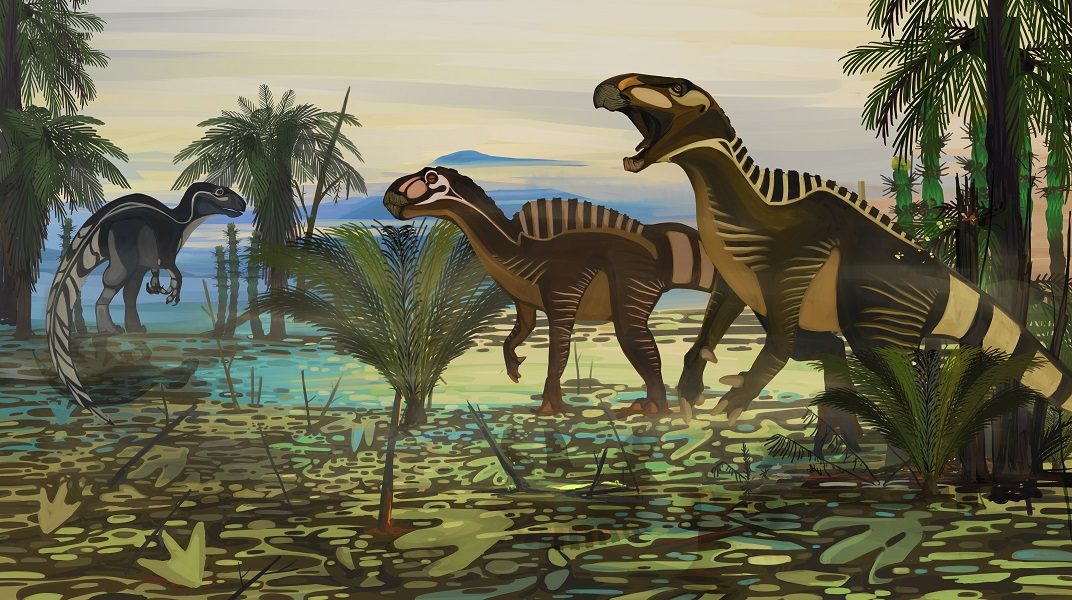
Iguanodon: Bexhill’s Dinosaurs
29 July - 31 October

This summer, travel back 133 million years without leaving the Sussex coast! Bexhill Museum’s summer exhibition, Iguanodon: Bexhill’s Dinosaurs, invites visitors of all ages to explore a time when dinosaurs roamed what is now our local shoreline. This fascinating family-friendly exhibition is on the remarkable prehistoric past beneath our feet.
Iguanodon: From Roadside Find to Dinosaur Icon
The story begins in 1822, inland from the Sussex coast, when Mary Ann Mantell spotted strange fossilised teeth by the side of the road in Whitemans Green. Her husband, Gideon Mantell, realised they looked like the teeth of a modern iguana—only far larger. He named the creature Iguanodon, and with that, Britain’s dinosaur story began.
But what we thought we knew about Iguanodon has changed a lot over the last two centuries. Once imagined as a clumsy, rhino-like reptile, the modern interpretation is far more dynamic.
Today’s scientific reconstructions show Iguanodon as an agile, social, plant-eating dinosaur with strong hind legs, a beak for cropping leaves, and even a sharp thumb spike—possibly used for defence or foraging. Fossils from around the world, including those found right here in Bexhill, have helped rewrite that story.
Our exhibition lets you trace this journey of discovery, with expert displays and beautiful illustrations by John Sibbick and Natalia Jagielska.
Bones from Bexhill: Dave Brockhurst’s Remarkable Discoveries
The real stars of the show are the fossilised bones of Iguanodontians found right here on the Bexhill coast. Many of these rare and important fossils were discovered, collected, and donated by local expert Dave Brockhurst, whose decades of careful fieldwork have made an enormous contribution to science and to the museum’s collection.
From limb bones and vertebrae to fossil teeth and claws, Dave’s finds give us an extraordinary glimpse into the lives of these dinosaurs. Recent scientific research on these remains has helped confirm that at least two Iguanodontian species once lived in what was then a lush, subtropical river delta: the bulky Barilium dawsoni and the spiny-backed Hypselospinus fittoni.
The display is accompanied by explanations of how these fossils were studied and what they reveal—ideal for inquisitive young minds and grown-up dino enthusiasts alike.
You’ll also discover how these dinosaurs might have lived and moved. Iguanodontians could walk on two or four legs, used their hands to grasp vegetation, and likely travelled in herds like modern-day wildebeest. Their chewing teeth and flexible jaws were perfectly adapted for munching on tough prehistoric plants such as horsetails, cycads and ginkgoes, many of which still grow today.
Footprints in Time: Walking with Dinosaurs
The final part of the exhibition focuses on perhaps the most magical of all dinosaur remains: fossil footprints. Preserved in sedimentary rocks on the beach at Bexhill, these tracks are the actual imprints of dinosaurs as they walked across the muddy shoreline millions of years ago.
Since the 1850s, these rare and fragile prints have fascinated local residents and scientists alike. Incredibly, they include the tracks of both plant-eating Iguanodontians and meat-eating theropods—the fearsome ancestors of Tyrannosaurus and many think, modern birds.
One trackway, filmed by the BBC’s Swap Shop in 1978, is part of Bexhill history. More recently, several new footprints were discovered by local resident Vicky Ballinger after a storm in 2024 and digitally preserved by researcher Tone Blakesley.
The exhibition explains how dinosaur footprints are made, how they become fossilised over millions of years. Visitors can view high-quality casts, and learn how scientists interpret these traces.
Plan Your Visit
Whether your child dreams of being a palaeontologist, or you’re just looking for something fascinating and fun to do by the sea, Iguanodon: Bexhill’s Dinosaurs is not to be missed. With fossil bones, interactive exhibits, footprint casts, and the real stories of local discovery, this is a true celebration of Bexhill’s prehistoric past—and the people helping to uncover it.
Bexhill Museum is open from 11am to 4pm every day except Mondays, including the August Bank Holiday. Admission includes access to all galleries and exhibitions, including displays on local history, fashion, and vintage motoring.

